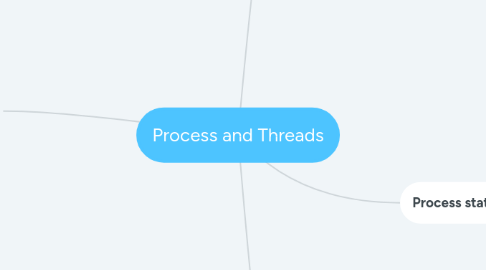
1. What is a process?
1.1. Background
1.1.1. program in execution
1.1.2. instance of a running program
1.1.3. entity that can be assigned to, and executed on, a processor
1.1.4. single sequential thread of execution, current, and an associated set of system resources
1.2. Processes and process control blocks
1.2.1. process elements
1.2.1.1. identifier
1.2.1.2. state
1.2.1.3. priority
1.2.1.4. program counter
1.2.1.5. memory pointers
1.2.1.6. context data
1.2.1.7. I/O status information
1.2.1.8. accounting information
2. Process states
2.1. Two-state process model
2.1.1. running
2.1.2. not-running
2.2. Creation and termination
2.2.1. creation
2.2.1.1. new batch job
2.2.1.2. interactive logon
2.2.1.3. created by OS to provide a service
2.2.1.4. spawned by existing process
2.2.2. termination
2.2.2.1. normal completion
2.2.2.2. time limit exceeded
2.2.2.3. memory unavailable
2.2.2.4. bounds violation
2.2.2.5. protection error
2.2.2.6. arithmetic error
2.2.2.7. time overrun
2.2.2.8. I/O failure
2.2.2.9. invalid instruction
2.2.2.10. privileged instruction
2.2.2.11. data misuse
2.2.2.12. operator or OS intervention
2.2.2.13. parent termination
2.2.2.14. parent request
2.3. Five-state model
2.4. suspended processes
2.4.1. swapping
2.4.2. other OS reason
2.4.3. Interactive user request
2.4.4. timing
2.4.5. parent process request
2.5. trace
2.5.1. listing the instructions that execute for that process
2.5.2. showing how the traces of the various processes are interleaved
2.6. dispatcher
2.6.1. switches the processor from one process to another
3. Processes and threads
3.1. processes
3.1.1. virtual address space
3.1.2. protected access to processors, other process, files and I/O resources
3.1.3. suspension and termination
3.2. threads
3.2.1. execution state
3.2.2. save context
3.2.3. an execution stack
3.2.4. some pre-thread static storage
3.2.5. access to the memory and resources of its process, shared with other threads of the process
4. Operating system control structures
4.1. manage processes and resources
4.2. OS constructs and maintains tables of information
4.3. types of tables maintained by the OS
4.3.1. Memory tables
4.3.2. IO tables
4.3.3. File tables
4.3.4. process tables

